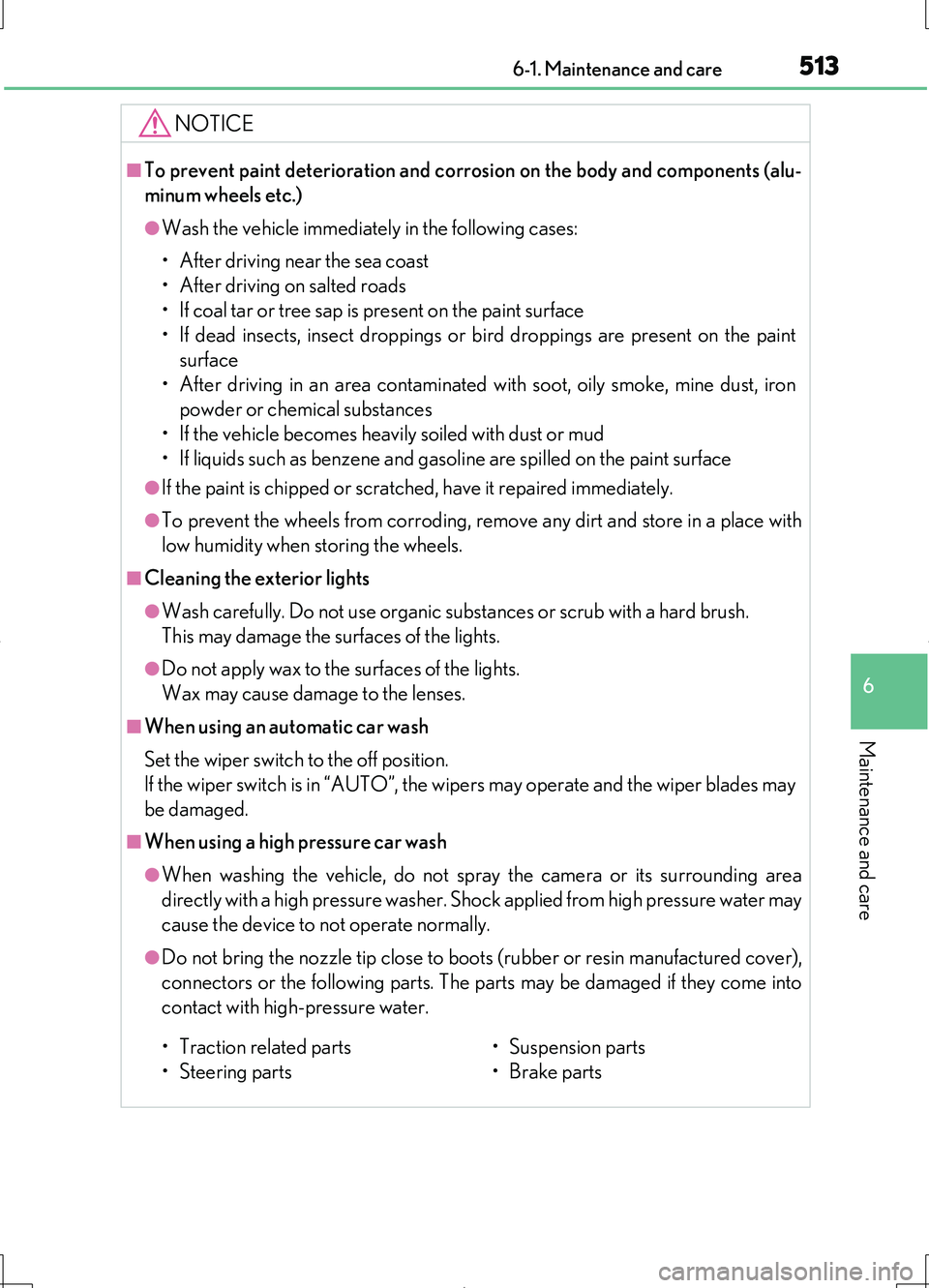Page 404 of 708

4044-6. Driving tips
LS460/LS460L_GE (OM50G06E)
◆Air conditioning
Use the air conditioning only when necessary. Doing so can help reduce
excessive fuel consumption.
In summer: When the ambient temperature is high, use the recirculated air
mode. Doing so will help to reduce the burden on the air conditioning system
and reduce fuel consumption as well.
In winter: Turn the A/C switch on only when both heating and dehumidifying
are needed, and if only heating is needed, turn the A/C switch off. Turning the
A/C switch on when unnecessary leads to excessive fuel consumption.
◆Performing idling stops
●Avoid unnecessary idling. Stop the engine when parking the vehicle to
reduce excessive fuel consumption, even it is only for a short period of time.
●Except in severe environment, such as when the outside temperature is
extremely low, warming up the engine before driving is unnecessary.
Rather than idling, it is more efficien t to drive the vehicle gently to warm up
each part while avoiding increasing the engine revolutions unnecessarily
and accelerating or decelerating suddenly.
◆Luggage
Carrying heavy luggage will lead to poor fuel economy. Avoid carrying
unnecessary luggage. Installing a large roof rack will also cause poor fuel
economy.
◆Regular maintenance
●Make sure to check the tire inflation pressure frequently. Improper tire
inflation pressure can cause poor fuel economy. Also, as snow tires can
cause large amounts of friction, their us e on dry roads can lead to poor fuel
economy. Use tires that are appropri ate for the season and road condi-
tions.
●Use oil and fluid of the recommended quality, which affect fuel consump-
tion and the life of the vehicle. Also, check oil and fluid periodically.
( P. 520)
Page 513 of 708

5136-1. Maintenance and care
6
Maintenance and care
LS460/LS460L_GE (OM50G06E)
NOTICE
■To prevent paint deterioration and corrosion on the body and components (alu-
minum wheels etc.)
●Wash the vehicle immediately in the following cases:
• After driving near the sea coast
• After driving on salted roads
• If coal tar or tree sap is present on the paint surface
• If dead insects, insect droppings or bird droppings are present on the paint
surface
• After driving in an area contaminated with soot, oily smoke, mine dust, iron
powder or chemical substances
• If the vehicle becomes heavily soiled with dust or mud
• If liquids such as benzene and gasoline are spilled on the paint surface
●If the paint is chipped or scratched, have it repaired immediately.
●To prevent the wheels from corroding, remove any dirt and store in a place with
low humidity when storing the wheels.
■Cleaning the exterior lights
●Wash carefully. Do not use organic substances or scrub with a hard brush.
This may damage the surfaces of the lights.
●Do not apply wax to the surfaces of the lights.
Wax may cause damage to the lenses.
■When using an automatic car wash
Set the wiper switch to the off position.
If the wiper switch is in “AUTO”, the wipers may operate and the wiper blades may
be damaged.
■When using a high pressure car wash
●When washing the vehicle, do not spray the camera or its surrounding area
directly with a high pressure washer. Shock applied from high pressure water may
cause the device to not operate normally.
●Do not bring the nozzle tip close to boot s (rubber or resin manufactured cover),
connectors or the following parts. The parts may be damaged if they come into
contact with high-pressure water.
• Traction related parts
• Steering parts
• Suspension parts
• Brake parts
Page 534 of 708

5346-3. Do-it-yourself maintenance
LS460/LS460L_GE (OM50G06E)
Tire inflation pressure (P. 568)• Tire pressure gauge
• Compressed air source
Washer fluid ( P. 553)
• Water or washer fluid containing anti-
freeze (for winter use)
• Funnel (used only for adding water or
washer fluid)
CAUTION
The engine compartment contains many mechanisms and fluids that may move sud-
denly, become hot, or become electrically energized. To avoid death or serious
injury, observe the following precautions.
■When working on the engine compartment
●Keep hands, clothing and tools away from the moving fan and engine drive belt.
●Be careful not to touch the engine, radiator, exhaust manifold, etc. right after driv-
ing as they may be hot. Oil and other fluids may also be hot.
●Do not leave anything that may burn easily, such as paper and rags, in the engine
compartment.
●Do not smoke, cause sparks or expose an open flame to fuel or the battery. Fuel
and battery fumes are flammable.
●Be extremely cautious when working on the battery. It contains poisonous and
corrosive sulfuric acid.
●Take care because brake fluid can harm your hands or eyes and damage painted
surfaces. If fluid gets on your hands or in your eyes, flush the affected area with
clean water immediately.
If you still experience disc omfort, consult a doctor.
■When working near the electric cooling fans or radiator grille
Be sure the engine switch is off.
With the engine switch in IGNITION ON mode, the electric cooling fans may
automatically start to run if the air conditioning is on and/or the coolant tempera-
ture is high. ( P. 549)
■Safety glasses
Wear safety glasses to prevent flying or falling material, fluid spray, etc. from get-
ting in your eyes.
ItemsParts and tools